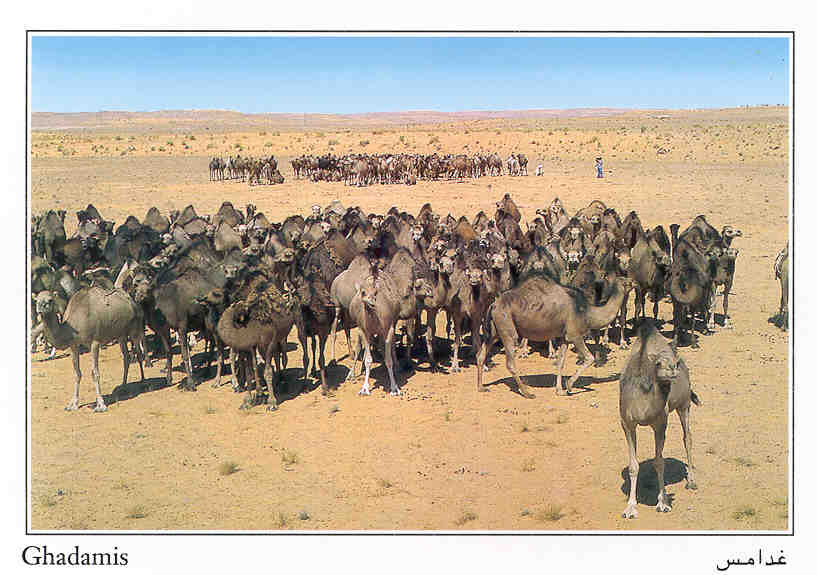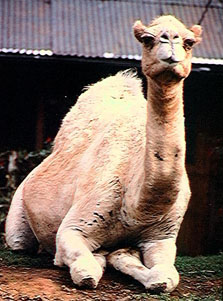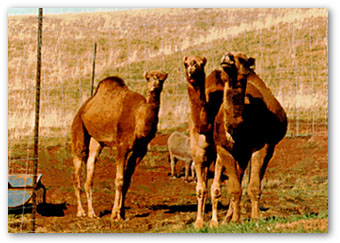Camels
![]()
amazing facts about camels
Camels can walk continuously for 34 days without drinking any water.
The speed of a camel walk reaches 30 km/day.
They can drink 19 to 27 Litters of water at one time.
Two rows of long eye lashes protect the camel´s eyes from the desert dust.
Their nostrils are covered with hair so they can be closed during desert storms.
Average height of their head is 213cm, and average shoulder height is 183 cm.
Camel´s fur grows thick in winter, especially around the neck and then diminishes in summer.
A camel reaches adult age after 5 years and can live up to 40 years.
They can lose 30% of body water due to thirst without any harm.
Body temperature can fluctuate from 34 degrees in the morning to more than 40 degrees walking at midday.
There are two basic types, Arabian (short fur, one hump) and Bactrian (long fur, two humps). They are known as the Ship of the Desert camels have broad, flat leathery pads with two toes on each foot. When the camel places its foot on the ground, the pads spread, preventing the foot from sinking into the sand. When walking, the camel moves both feet on one side of its body, then both feet on the other. This gait suggests the rolling motion of a boat, explaining the camel’s ‘ship of the desert’ nickname.
 They hardly need water they can travel for days without having to drink all that make them ideal for desert traveling. They are clumsy-looking, rather ugly animals. They have a lousy reputation because they are believed to spit and kick at people (I personally did lived around Camels up till I was 16 years old they do Kick if they are anger at you but I never seen them spit). Yet for many North African and Middle Eastern cultures these daft animals are crucial.
They hardly need water they can travel for days without having to drink all that make them ideal for desert traveling. They are clumsy-looking, rather ugly animals. They have a lousy reputation because they are believed to spit and kick at people (I personally did lived around Camels up till I was 16 years old they do Kick if they are anger at you but I never seen them spit). Yet for many North African and Middle Eastern cultures these daft animals are crucial.
The camel has been their desert vehicle for centuries. But today’s Bedouins prefer four-wheel drives, camels have become more valued as racing animals and sentimental symbols of the past.
Camels stand from 6 - 7 feet tall and weigh from 1,000 - 1,600 lb. with tails about 21" long. They loose their fur in the spring and grow new coats by autumn. The young can run shortly after birth but generally stay with their mothers for four years.
The gestation period is 11 months. Most are born one at a time, twins are rare. They live from 17 - 50 years. Camels have 3 thick layers of eyebrows that shades the eyes from the sun. They can shut their nostrils and lips tightly to prevent sand from blowing in. They also have long, strong legs and can carry 1,000 lb. long distances.  They eat dates, grass and grains like wheat and oats, dried leaves, seeds and plants they can find. They have stomachs with 3 sections. One to store poorly chewed food (cud). It is returned to the mouth and chewed later. Then it goes to other parts of the stomach to be fully digested. Camels, deer and cattle that do this are called ruminants.
They eat dates, grass and grains like wheat and oats, dried leaves, seeds and plants they can find. They have stomachs with 3 sections. One to store poorly chewed food (cud). It is returned to the mouth and chewed later. Then it goes to other parts of the stomach to be fully digested. Camels, deer and cattle that do this are called ruminants.
Long ago, camels were the only means to cross the desert. Because camels were brought up in the desert, they adapted many qualities that enabled them to survive the harsh conditions, some of which include the ability to withstand dehydration.
Camels can go without water for days or even months. They will drink only what they need to replace their body moisture. When they do drink water, they can ingest up to seven gallons a day. Camels have even been known to swallow 20 gallons of water in 10 minutes. Camels keep most of the water that is in their bodies. They don’t sweat much. Their body temperature changes as much as 10 Fahrenheit degrees without harm. In people, an increase of 2 or 3 degrees is usually a sign of illness.
The camel also provides meat, milk, wool, hides, transport and shade for the owners.
But all these qualities are becoming less and less vital to the Bedouin as these nomadic tribes succumb to technological advances. Instead of camels, they use four-wheel drives. Increasingly, camels are used for camel races, which have become an important and money-generating event in some Arab countries, such as the Emirates and Saudi Arabia. Along with this sport, training and breeding facilities have mushroomed.
Camels are truly a sign of one of the many blessings given to man from the Lord of the worlds. They have natural adaptations to a scarcity of food and water and should be looked at and imitated in their conservation thereof.
A camel has a special place in the Bedouin heart and mind. This animal, cute and ugly at the same time, with its extraordinary characteristics, enabled the Bedouin to survive desert conditions for centuries. Now camels contribute to the tourism industry, as they are used in camel races. And in many Arab countries camels are placed in tourist attractions where tourists pay a minimal fee to have a ride.
Along with this sport, training and breeding facilities have mushroomed.
Camels are truly a sign of one of the many blessings given to man from the Lord of the worlds. They have natural adaptations to a scarcity of food and water and should be looked at and imitated in their conservation thereof.
A camel has a special place in the Bedouin heart and mind. This animal, cute and ugly at the same time, with its extraordinary characteristics, enabled the Bedouin to survive desert conditions for centuries. Now camels contribute to the tourism industry, as they are used in camel races. And in many Arab countries camels are placed in tourist attractions where tourists pay a minimal fee to have a ride.
Main page | Homeland | Pictures | Packers | More to come | Top of this page
© 1997 hatms@new.rr.com
![]()